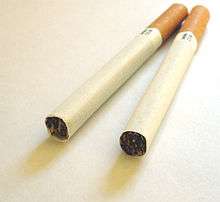Sturm Cigarette Company
The Sturm Cigarette Company (Sturm Zigaretten, Storm Cigarettes or Military Assault Cigarettes) was a cigarette company created by the Nazi Party's Sturmabteilung (SA).[1] The sale of its cigarettes provided the SA with operating funds[2][3] and a channel for political messaging.[4] Coercion and violence were used to increase sales.[3][5]
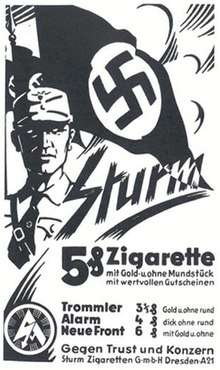
Founding
During the 1920s, many cigarette firms in Germany closed, and the market was increasingly dominated by a few large and highly automated manufacturers. By 1933, the Nazi party was attacking the tobacco industry for having foreign and Jewish connections.[2]
In 1929, Arthur Dressler cut a deal with the SA: together, they would found a cigarette manufacturer, and SA members would smoke its cigarettes, with the SA getting a royalty[6] of 15–20 pfennig for every thousand cigarettes sold[8] (0.45–0.6% of sales price, given most cigarettes sold at 31⁄3 pfennig).[3][9] At the time, the SA charged no membership fees and was thus financially dependent on donations from the Nazi party leadership; an independent income source was welcomed.[2]
Approached through Saxon Nazi party leader Manfred von Killinger, SA-Stabschef Otto Wagener was interested and willing to put money towards an SA cigarette factory. The Nazi party offered 30,000 reichsmarks in start-up money and, as this was nowhere near enough, Nazi party supporter Jacques Bettenhausen invested another 500,000 reichsmarks.[10] The Zigarettenfirma Sturm was founded, and registered as the Cigarettenfabrik Dressler.[7]
Marketing
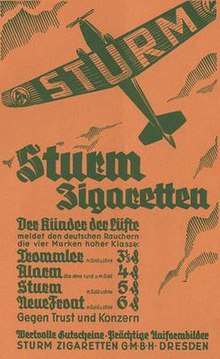
The factory mainly produced four brands: Trommler (Drummer), Alarm, Sturm (Storm) and Neue Front (New Front).[5] "Neue Front" was the most expensive brand, at six pfennig; "Sturm" cost five, and "Alarm" four. "Trommler" was the cheapest at 31⁄3 pfennig[9] and, given the economic crisis, by far the most popular. In 1932, 80% of cigarettes sold were "Trommler", rising to 95% by 1933.[3]
In early advertisements, all four main brands were listed; Nazi party imagery and the political slogan "Gegen Trust und Konzern" ("Against the [corporate] trust and the combine") were used. Later marketing focused on the "Trommler" brand. Apart from print advertising, the company owned a sound truck and hired advertising planes.[3] Cigarette marketing reflected the political and economic situation. For instance, in 1930–1932, during the economic crash, advertisements showing catastrophic situations were common.[3]
Sturm marketing was also used to make the prospect of serving in the German army more appealing.[4] Cigarettes were sold with collectable sets of images of historical German military uniforms.[4][11][9] While the SA was officially the sports and gymnastics division of the Nazi party, it was a successor to the banned Freikorps militias,[12] and promoted itself as a military training program.[13]
Adolf Hitler's opposition to smoking had limited effects on consumption and sales. While he ordered many localized smoking bans, they were widely ignored. The finance ministry appreciated the taxes tobacco brought in:[14] by 1941, about a twelfth of state revenues.[15] Aside from taxes, advertising revenues, and Sturm royalties and dividends, Nazi organizations accepted millions of reichsmarks in donations and bribes from the cigarette industry.[2][16][15] The propaganda minister's view was decisive; Joseph Goebbels felt that cigarettes were essential to the war effort.[14] Cigarettes were distributed free to soldiers, including minors, as part of their pay.[15]
Between 1930 and 1940, the per-capita cigarette consumption of Germany rose from 500 to 1000 cigarettes a year;[16] tens of billions of cigarettes were sold annually.[17]
Coercion
There is evidence that coercion was used to promote the sale of these cigarettes.[5] SA members were not just expected to smoke Sturm Cigarette Company cigarettes exclusively,[1] they were compelled to:[2] there were bag searches, and fines if any other brand were found.[3] The SA agitated against and punished the use of other brands, especially the market leader Reemtsma.[2][7] SA men attacked shops that sold rival brands,[2][7] smashing windows and physically attacking the shopworkers.[3]
Profits
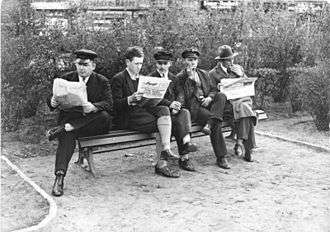

Through this scheme, a typical SA unit earned hundreds of reichsmarks each month.[5] A hundred marks would be the SA earnings from the sale of 500,000 cigarettes, at 20 pfennig per thousand.[18] A typical German smoker smoked around 15 cigarettes a day[14] (similar to modern rates[19]), so this would be income from just over a thousand smokers.
At the time, an average-intensity "Trommler" smoker[14] paid the average wage[20] would spend around a tenth of his gross income on cigarettes.[21] Many did not have a regular wage: this was the time of the Great Depression, and unemployment peaked at over 30% (see graph). The SA recruited particularly among the unemployed and underemployed.[22]
The firm first paid dividends to the SA in 1930. By 1932, it had a turnover of 36 million reichsmarks (equivalent to €125 million in 2009), and the SA made considerable profits; 1933 saw even higher returns. Money went to buy new buildings, factories, and advertising.[3]
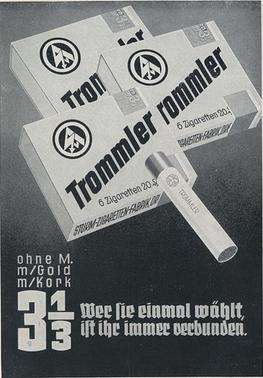
Replacement
In June 1932, Philipp Fürchtegott Reemtsma, head of the Reemtsma cigarette company, met with Adolf Hitler, Rudolf Hess, and Max Amann[2] (Hitler's secretary, and the head of Eher Verlag, the Nazi party's printing house[23]). Reemtsma's advertisements had been banned from Nazi party publications, but the publications lost money, and the party needed money for election campaigning. Hitler scolded Reemtsma for having Jewish partners, but they agreed to an initial deal of half a million marks of advertising.[2]
Shortly after the Nazis took power in 1933, Philipp Reemtsma asked Hermann Göring, then the highest official in Prussia, to do something about charges of corruption and SA attacks against the company. In early 1934, Göring called off the court case in exchange for three million marks; Reemtsma subsequently paid him a million more per year, as well as making to substantial donations to the party. By July 1934 the Night of the Long Knives had removed the threat of the SA: its leaders, who had profited from the firm's royalties, and often owned shares in it, were dead or imprisoned.[2]
Reemtsma's Jewish partners had now emigrated, along with many Jewish employees, with help from Reemtsma.[2] After Reemtsma made inquiries, the new SA leader, SA-Stabschef Viktor Lutze, cancelled their contract with Sturm Cigarettes and made a deal with Reemtsma in exchange for a fixed sum (in 1934, 250,000 reichsmarks), paid annually. Reemtsma would now produce the SA's cigarettes, and Sturm, left with unsellable cigarettes,[2] filed for bankruptcy in 1935.[3]
See also
- Reemtsma (Sturm's successor as the SA cigarette company)
- Health effects of tobacco
- Nicotine marketing, History of nicotine marketing
- Anti-tobacco movement in Nazi Germany
References
- Proctor, Robert (1999). The Nazi war on cancer. Princeton, N.J: Princeton University Press. pp. 234–237. ISBN 978-0-691-00196-8.
- Erik Lindner. "Zwölf Millionen für Göring". Cicero Online. Retrieved 2018-08-20.
- Daniel Siemens (2013-09-11). "Nazi storm-troopers' cigarettes" (University department). UCL SSEES Research Blog. Retrieved 2018-08-25.
- Goodman, Joyce; Martin, Jane (2002). Gender, colonialism and education: the politics of experience. London; Portland, OR: Woburn Press. p. 81. ISBN 0-7130-0226-3.
- Grant, Thomas D. (2004). Stormtroopers and crisis in the Nazi movement: activism, ideology and dissolution. London ; New York: Routledge. p. 102. ISBN 978-0-415-19602-4.
- Kershaw, Ian (2000). Hitler, 1889–1936: hubris (1st Norton paperback ed.). New York: Penguin. p. 348. ISBN 978-0-393-32035-0.
- Thomas Grosche, Arthur Dressler: die Firma Sturm - Zigaretten für die SA. Chapter in Braune Karrieren: Dresdner Täter und Akteure im Nationalsozialismus. Christine Pieper, Mike Schmeitzner, Gerhard Naser (eds.). Dresden: Sandstein Verlag. 2012. ISBN 978-3-942422-85-7.CS1 maint: others (link)
- "Buchkritik: Der Sammelband "Braune Karrieren: Dresdner Täter und Akteure im Nationalsozialismus"". Retrieved 2018-08-20., citing [7]
- "Reklame für Zigarettensorte STURM ZIGARETTEN mit Porträts von Yorck und Blücher. Umschlag Rückseite innen von Programmheft Sächsische Staatstheater, Schauspielhaus Dresden. 03.06.1933. Druck; 22,3 x 16,3 cm. Dresden: SLUB Z.4.8 - Deutsche Digitale Bibliothek". Retrieved 2018-08-26.
- Lindner, Erik (2007). Die Reemtsmas: Geschichte einer deutschen Unternehmerfamilie (1. Aufl ed.). Hamburg: Hoffmann und Campe. ISBN 978-3-455-09563-0.
- "Adolf Hitler exhibition in Germany: Hitler and the Germans at the German Historical Museum in Berlin". 2010-10-14. ISSN 0307-1235. Retrieved 2018-08-26.
- Waite, Robert G. L. (1969) [1952]. Vanguard of Nazism: The Free Corps Movement in Post-War Germany, 1918–1923. New York, NY: W. W. Norton & Company. OCLC 3633548., described in this "review".
- For instance, in its widely publicized weekly publication, Der SA-Mann.United States Office of Chief of Counsel for the Prosecution of Axis Criminality (1946). "Chapter XV Part 4 - THE STURMABTEILUNG (SA)". Nazi Conspiracy and Aggression (Vol. II).
- Waibel, Ambros (2015-12-21). "Tabak und Kaffee im Dritten Reich: "Verbote wurden ignoriert"". Die Tageszeitung: taz. ISSN 0931-9085. Retrieved 2018-08-27.
- Bachinger, Eleonore; McKee, Martin; Gilmore, Anna (May 2008). "Tobacco policies in Nazi Germany: not as simple as it seems". Public Health. 122 (5): 497–505. doi:10.1016/j.puhe.2007.08.005. ISSN 0033-3506. PMC 2441844. PMID 18222506.
- "Rauchzeichen: Fotoarchiv Reemtsma in der NS-Zeit" (Museum). Retrieved 2018-08-25.
- Roth, Karl Heinz; Abraham, Jan-Peter (2011). Reemtsma auf der Krim: Tabakproduktion und Zwangsarbeit unter der deutschen Besatzungsherrschaft 1941-1944. Schriften der Stiftung für sozialgeschichte des 20. Jahrhunderts (1. Aufl ed.). Hamburg: Edition Nautilus. ISBN 978-3-89401-745-3.
- calculation from numbers given earlier, and on hundred pfennigs to the mark
- "Raucherstatistiken". Retrieved 2018-08-28.
- "Anlage 1 SGB 6 - Einzelnorm". www.gesetze-im-internet.de.
- Calculation from figures given in sources; an annual income of ~1600 marks per year, and smoking costs of 0.035 marks for each cigarette, 15 cigarettes a day, and 365.25 days a year
- Klußmann, Uwe (2012-11-29). "Conquering the Capital: The Ruthless Rise of the Nazis in Berlin". Spiegel Online.
- "Max Amann: Werke aus Sammlung von Hitlers Verleger entdeckt". Die Welt. 2014-06-13. Retrieved 2018-08-26.
Further reading
- Bachinger, Eleonore; McKee, Martin; Gilmore, Anna (May 2008). "Tobacco policies in Nazi Germany: not as simple as it seems". Public Health. 122 (5): 497–505. doi:10.1016/j.puhe.2007.08.005. ISSN 0033-3506. PMC 2441844. PMID 18222506.
- Petrick-Felber, Nicole (2015). Kriegswichtiger Genuss: Tabak und Kaffee im "Dritten Reich". Beiträge zur Geschichte des 20. Jahrhunderts. Göttingen: Wallstein Verlag. ISBN 978-3-8353-1666-9.; interview of the author about the book: Waibel, Ambros (2015-12-21). "Tabak und Kaffee im Dritten Reich: "Verbote wurden ignoriert"". Die Tageszeitung: taz. ISSN 0931-9085. Retrieved 2018-08-27.
- Siemens, Daniel (2017). Stormtroopers: a new history of Hitler's Brownshirts. New Haven: Yale University Press. ISBN 978-0-300-19681-8.; shorter text by author: "Nazi storm-troopers' cigarettes". 2013-09-11.
- Braune Karrieren: Dresdner Täter und Akteure im Nationalsozialismus. Christine Pieper, Mike Schmeitzner, Gerhard Naser (eds.). Dresden: Sandstein Verlag. 2012. ISBN 978-3-942422-85-7.CS1 maint: others (link)
